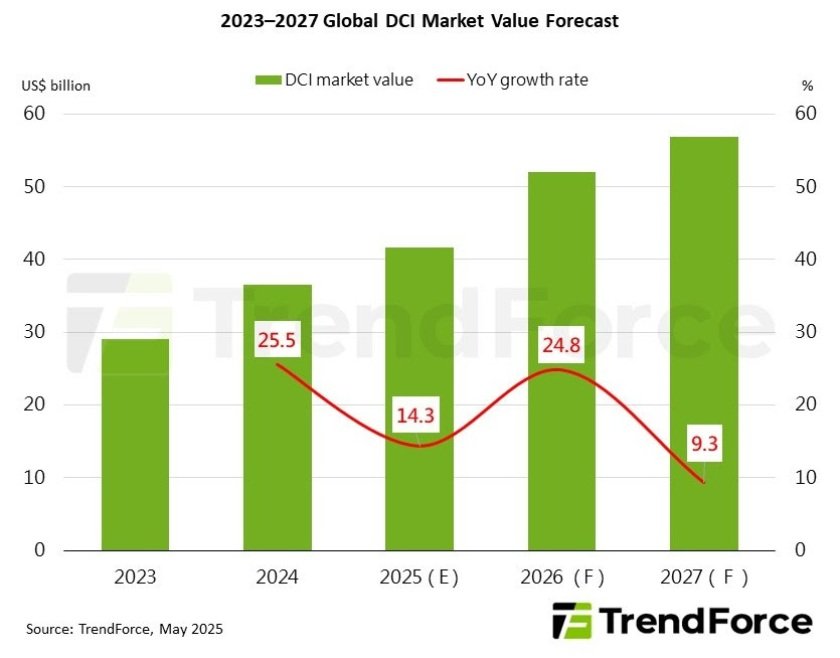The size of the global optical transport equipment market fell 1 percent in Q1-2025, according to the latest report from Dell’Oro Group. The optical transport equipment market in North America surged 24 percent, driven by accelerating demand for data center interconnect (DCI) infrastructure.

The global DCI market is expected to grow 14.3 percent, surpassing $40 billion in 2025. DCI enables high-speed data transfer between data centers, easing AI-related computational demands. Implementation is progressing through partnerships between telecom operators and optical equipment providers in regions such as the US, Northern Europe, and Southeast Asia.
According to TrendForce, major telecom providers like SK Telecom and Deutsche Telekom are launching Agentic AI services as generative AI becomes more integrated into daily life in 2025. To support this growth, telecom companies and cloud service providers are expanding their data centers, boosting demand for DCI technology.

North America Leads the Charge
As cloud computing, AI workloads, and streaming services expand, large internet content providers are ramping up investments in DWDM (Dense Wavelength Division Multiplexing) systems to scale capacity between data centers. Dell’Oro attributes a more than 40 percent increase in DCI-related spending in North America to this shift, marking a record revenue quarter for the region.
“We are seeing renewed spending…now that we are out of the customer inventory correction phase,” said Jimmy Yu, VP at Dell’Oro Group. This signals a rebound from the recent slowdown caused by oversupply and cautious spending post-pandemic. In addition to direct DCI infrastructure, Yu noted that managed networks built by operators on behalf of hyperscalers are also expanding, suggesting a broader investment trend.
Regional Winners and Losers
While North America was the standout performer, two other regions—India and the Middle East & Africa — also saw double-digit growth, indicating a broader momentum in markets investing in next-gen infrastructure. In contrast, four major markets — China, Europe, Japan, and Latin America — registered year-over-year declines, reflecting either saturation, economic headwinds, or delayed recovery from inventory imbalances.
This divergence highlights a global market increasingly defined by localized dynamics: while some regions push aggressively into new build-outs, others are still in a digestion phase or facing economic constraints.
Vendor Dynamics and Industry Shifts
Vendor performance further underscores the changing market landscape. Huawei, Ciena, and Nokia led the quarter, all posting positive growth, but with stark differences. Nokia’s 54 percent growth was significantly boosted by its February 2025 acquisition of Infinera, which contributed one month of added revenue. Even adjusting for the acquisition, the combined entity saw a healthy 19 percent growth, signaling successful synergy and strong market positioning.
Ciena’s 15 percent growth is also noteworthy, reflecting its strength in North America and possibly its alignment with rising DCI demand. Huawei, facing geopolitical and supply chain pressures in several regions, managed only 2 percent growth, suggesting its dominance in certain markets like China may not be translating into broader global gains this quarter.
WDM Segment Outlook: Metro Struggles, Long Haul Recovers
Within the WDM segment, the divergence between long-haul and metro systems continues. While DWDM Long Haul posted growth for a second straight quarter—driven by large-scale inter-data center deployments — WDM Metro declined for a seventh consecutive quarter. Analysts attribute this to the growing adoption of IP-over-DWDM (IPoDWDM), which reduces the need for standalone WDM equipment in metro networks, as well as lingering inventory and macroeconomic challenges.
Outlook
While global headline figures suggest a flat market, the underlying dynamics reveal strong momentum in specific regions and applications, particularly in hyperscale data connectivity. The strength in North America, fueled by hyperscalers’ insatiable demand for capacity, is a bullish signal for vendors aligned with DCI solutions. However, persistent weakness in key markets like China and Europe, and structural changes in metro optical architecture, present challenges.
Going forward, the market’s trajectory will likely hinge on how quickly underperforming regions recover and whether DCI-led demand sustains its momentum globally. The integration of technologies like IPoDWDM, and vendor consolidation such as Nokia’s acquisition of Infinera, are poised to reshape the competitive and technological landscape of the optical transport sector in 2025 and beyond.
Baburajan Kizhakedath
